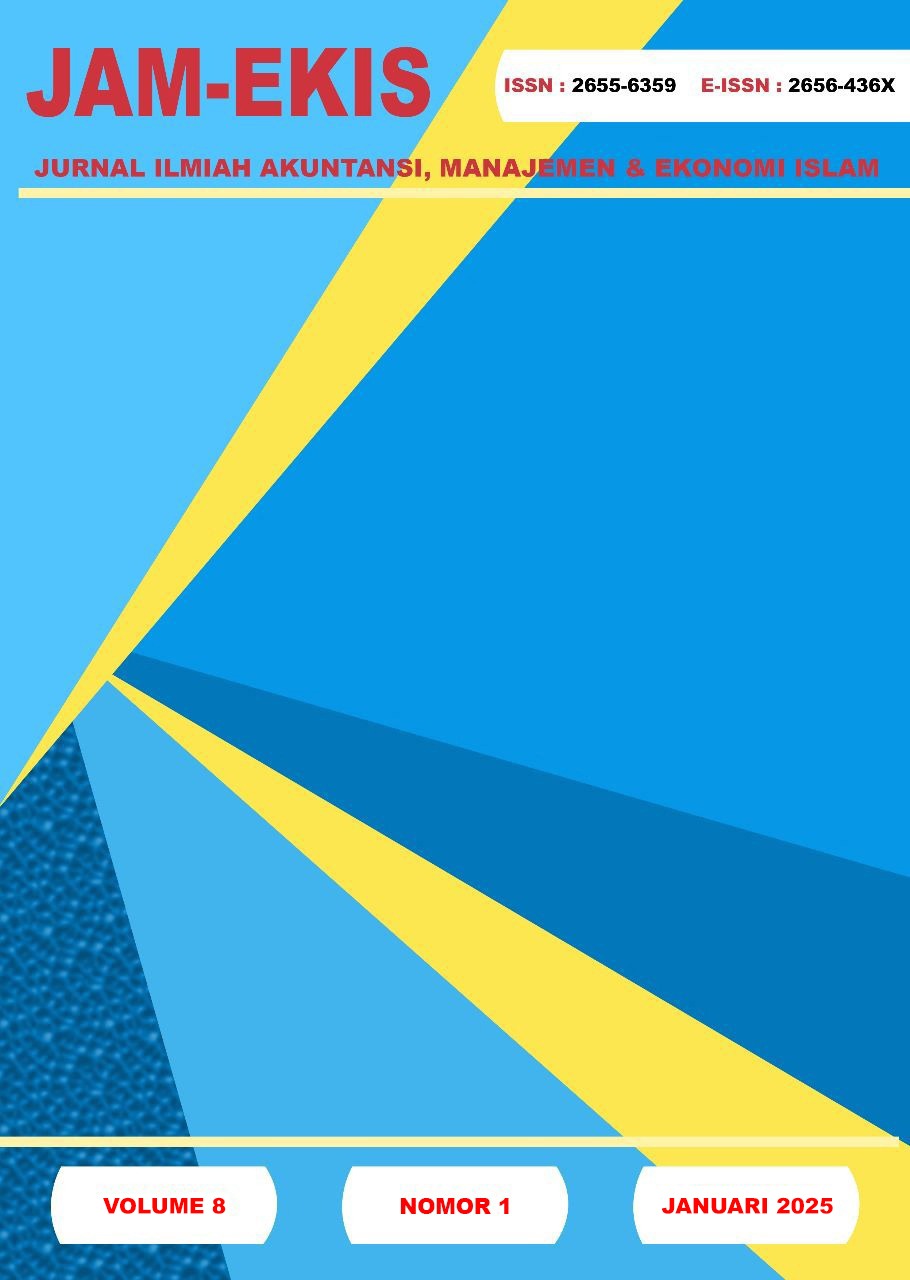PENGARUH PERFORMANCE EXPECTANCY, EFFORT EXPECTANCY, DAN SOCIAL INFLUENCE TERHADAP ADOPSI E-COMMERCE DI KALANGAN GENERASI MILENIAL
DOI:
https://doi.org/10.36085/jamekis.v8i1.7431Abstract
The rapid development of digital technology has driven the rapid growth of e-commerce. Millennials, as a generation that is very familiar with technology, have become the primary target for e-commerce businesses. This research aims to determine the factors that influence users in using e-commerce for transactions. The research model used is the Unified Theory of Acceptance and Use of Technology (UTAUT2) with independent variables: performance expectations, effort expectancy, and social influence. This research method is a quantitative method using a questionnaire distributed via social media. This research sample consisted of 108 respondents. The data analysis used is Smart PLS. The results of this study show that effort expectancy has no positive effect on behavioral intentions, whereas performance expectancy and social influence have a positive effect on the behavioral intentions of the millennial generation in using e-commerce services. The contribution in this research provides a significant contribution in understanding the factors that influence the use of e-commerce among the millennial generation. It is hoped that the results of this research can help e-commerce developers, marketers, and policymakers in designing more effective strategies to increase the adoption and use of e-commerce among millennials.
References
Ajzen, I. (1991). The Theory of Planned Behavior. Organizational Behavior and Human Decision Processes, 50: 179-211.
Alvara Research Center. (2017). The Urban Middle-Class Millenials Indonesia. 40. https://alvara-strategic.com/.
Anugrah, Z., Suhaebah, L., Pramudita, T. R., & Yusuf, R. (2024). Pengaruh Performance Expectancy, Effort Expectancy, Social Influence pada Behavioral Intention Aplikasi Gojek di Kabupaten Garut. ANALYSIS: Accounting, Management, Economics, and Business 2 (1). https://doi.org/10.56855/analysis.v2i1.908.
Arie, A., Siti, H., Handayani, R., & Susilo, H. (2015). Analisis atas Praktek TAM (Technology Acceptance Model) Dalam Mendukung Bisnis Online dengan Memanfaatkan Jejaring Sosial Instagram. Jurnal Administrasi Bisnis (JAB) Vol (Vol. 26, Issue 1).
Ati Haryati, R., & Lestari, R. (2020). Factors Influencing Online Buying Behaviour of Millennial Generation. Yogyakarta Conference Series Proceeding on Economic and Business Series (EBS), 1(1), 165–171. https://doi.org/10.31098/ebs.v1i1.64.
Bank Indonesia. (2023). Laporan Perkembangan Pembayaran Digital di Indonesia.
Cindy Mutia Annur. (2023, June 22). Transaksi E-commerce Konsumen Usia Tua Terus Meningkat Ketimbang Gen Z dan Milenial. Katadata.Com.
Davis, F. D., Bagozzi, R. P., & Warshaw, P. R. (1989). User Acceptance of Computer Technology: A Comparison of Two Theoretical Models. Management Science, 35(8), 982–1003. https://doi.org/10.1287/mnsc.35.8.982.
Dr. Nasrul Fadhrullah, & Isa Sharifah Nurafizah. (2022). Factors Influencing Online Purchase Intention of Millennials and Gen Z Consumers. Journal of Applied Structural Equation Modeling, 21–43. https://doi.org/10.47263/JASEM.4(2)03.
Dwi Oktavianita, A., & Siregar, M. U. (2021). Pengaruh Faktor Model UTAUT (Unified Theory of Acceptance and Use of Technology) Terhadap Niat Generasi Milenial Dalam Menggunakan Mobile Banking di Indonesia. Jurnal EK&BI, 4, 2620–7443. https://doi.org/10.37600/ekbi.v4i2.414.
Escobar-Rodríguez, T., & Carvajal-Trujillo, E. (2014). Online Purchasing Tickets for Low-Cost Carriers: An Application of The Unified Theory of Acceptance and Use Technology (UTAUT) Model. Tourism Management, 43, 70–88. https://doi.org/10.1016/j.tourman.2014.01.017
Fadli, Muchtar, Y. C., & Qamariah, I. (2019, November 1). E-Marketplace Acceptance and Use by Millennials for Business Start-Up. https://doi.org/10.2991/icoi-19.2019.27.
Finthariasari, M. F., Herwan, M. D. K., & Nita, Z. A. (2023). The Influence Of Promotional Strategies And Social Media On Purchase Decisions (Case Study on Buyers Using Ms Glow Skincare in Bengkulu City). Ekombis Review: Jurnal Ilmiah Ekonomi Dan Bisnis, 11(1), 857-866.
Finthariasari, M. F., Ratnawili, R., & Halim, N. (2022). Purchasing Decisions: The Analysis Effect Of The Variables Life Style, Celebrity Endorser, And Brand Image. EKOMBIS REVIEW: Jurnal Ilmiah Ekonomi Dan Bisnis, 10(2), 661-672.
Finthariasari, M., & Zetira, A. M. (2022). Purchase Intention: Pengaruh Price Discount, Bonus Pack Dan Celebrity Endorser. Jurnal Bisnis dan Manajemen (JBM), 16-25.
Fitri, Marliza Ade., Khairiyah, Diah.(2015). Persepsi Konsumen Terhadap Penjualan Melalui Media Internet (Studi Kasus Pada Mahasiswa Fakultas Ekonomi Universitas Muhammadiyah Bengkulu Angkatan Tahun 2015). Jurnal Ilmiah Akuntansi, Manajemen dan Ekonomi Islam (JAM-EKIS).
Ghozali I. dan Latan H. (2015). Partial Least Squares Konsep, Teknik dan Aplikasi Menggunakan Program SmartPLS 3.0 (2nd ed.). Badan Penerbit Universitas Diponegoro.
Hair, J. F., Sarstedt, M., Hopkins, L., & Kuppelwieser, V. G. (2014). Partial Least Squares Structural Equation Modeling (PLS-SEM): An Emerging Tool in Business Research. In European Business Review (Vol. 26, Issue 2, pp. 106–121). Emerald Group Publishing Ltd. https://doi.org/10.1108/EBR-10-2013-0128.
Indrawati. (2018). Analyzing Factors Influencing Continuance Intention of E-Payment Adoption Using Modified UTAUT 2 Model. IEEE.
Kamal, R. M., & Azis, E. (2015). Adopsi Teknologi Internet oleh Konsumen UMKM Indonesia untuk Berbelanja Online (Studi pada situs Tokopedia.com Tahun 2015).
Kementerian Pemberdayaan Perempuan dan Perlindungan Anak 2017. (2017). Hari Kependudukan Dunia 2017: Masa Depan Demografi Indonesia dan Keseimbangan Pertumbuhan Penduduk.
Khatimah, H., Pertamina, U., Susanto, P., Negeri, U., Nor, P., & Abdullah, L. (2019). Hedonic Motivation and Social Influence on Behavioral Intention of E-Money: The Role of Payment Habit as A Mediator. In International Journal of Entrepreneurship (Vol. 23, Issue 1)
Kusuma, M., Arianto, T., & Finthariasari, M. (2021). Analisis Pengaruh Minat Dan Motivasi Terhadap Keputusan Memilih Program Studi Dimediasi Variabel Pekerjaan Yang Diharapkan. Jurnal Manajerial, 8(03), 278-293.
Oktarini, D., Finthariasari, M., Nuari, T. N. V., Marta, F. R., & Yami, F. M. (2022, April). Strategi Desain Produk Dan Kualitas Produk Terhadap Minat Beli Konsumen Pada Toko Mebel Sederhana. In Prosiding Seminar Nasional Business Corporate (Vol. 1, No. 1, pp. 135-146).
Rudhumbu, N. (2022). Factors That Influence University Academics’ Intention to Use Blended Learning Approach In An ODL Environment: An Analysis Using UTAUT Model. International Journal of Education and Development Using Information and Communication Technology, 18 (1), 71–90.
Safitri, D., Faruk Sofyan, J., Angga Negoro, D., & Kusmayadi, A. (2024). Analisis Behavioral Intention Mobile Banking dengan Model UTAUT2. INNOVATIVE: Journal of Social Science Research, 4, 571–587.
Sair, S. A., Commer, P. J., Sci, S., & Danish, R. Q. (2018). Effect of Performance Expectancy and Effort Expectancy on the Mobile Commerce Adoption Intention through Personal Innovativeness among Pakistani Consumers. In Pakistan Journal of Commerce and Social Sciences (Vol. 12, Issue 2). https://www.researchgate.net/publication/327702133.
Singh, N., Sinha, N., & Liébana-Cabanillas, F. J. (2020). Determining Factors in The Adoption and Recommendation of Mobile Wallet Services in India: Analysis of The Effect of Innovativeness, Stress to Use and Social Influence. International Journal of Information Management, 50, 191–205. https://doi.org/10.1016/j.ijinfomgt.2019.05.022.
Sinulingga, N. A. B., Ginting, P., Sembiring, B. K. F., & Silalahi, A. S. (2024). A Study Intention, Implementation and Adoption of E-Wallet in Indonesia. Journal of Infrastructure, Policy and Development, 8(11), 8857. https://doi.org/10.24294/jipd.v8i11.8857.
Sismanto, A., Ranidiah, F., & Tarisa, A. (2021). Pengaruh orientasi pasar dan inovasi produk terhadap kinerja bisnis (studi kasus pada toko roti panggang banjar di sawah lebar kota bengkulu). Jurnal Ilmiah Akuntansi, Manajemen dan Ekonomi Islam (JAM-EKIS), 4(2).
Slade, E., Williams, M., Dwivedi, Y., & Piercy, N. (2015). Exploring consumer adoption of proximity mobile payments. Journal of Strategic Marketing, 23(3), 209–223. https://doi.org/10.1080/0965254X.2014.914075.
Suastiari, N. K. S., & Mahyuni, L. P. (2022). Determinants Of E-Commerce User Satisfaction: The Mediating Role of Purchase Intention. Jurnal Ekonomi Bisnis Dan Kewirausahaan, 11(3), 345. https://doi.org/10.26418/jebik.v11i3.56329
Sunardi, Tedy., Fikri, Muhammad.(2024). Pengaruh Faktor Geografis Dan Demografis Dalam Keputusan Pembelian (Studi Kasus Pada Konsumen Umkm Di Kawasan Wisata Pantai Kota Bengkulu). Jurnal Ilmiah Akuntansi, Manajemen dan Ekonomi Islam (JAM-EKIS), 7(2).
Susilawati, W., & Rawati Suganda, F. (2021). Faktor-Faktor Yang Mempengaruhi Keputusan Konsumen Dalam Menggunakan Jasa Ekspedisi. Jurnal Komunikasi Universitas Garut: Hasil Pemikiran dan Penelitian, 2, 725–734. www.journal.uniga.ac.id
Taiwo, A. A., & Downe, A. G. (2013). The Theory of User Acceptance and Use of Technology (UTAUT): A Meta-Analytic Review of Empirical Findings. Journal of Theoretical and Applied Information Technology, 10(1). www.jatit.org
Venkatesh, V., Smith, R. H., Morris, M. G., Davis, G. B., Davis, F. D., & Walton, S. M. (2003). Quarterly User Acceptance of Information Technology: Toward A Unified View 1.
Venkatesh, V., Walton, S. M., Thong, J. Y. L., & Xu, X. (2012). Consumer Acceptance and Use of Information Technology: Extending The Unified Theory of Acceptance and Use of Technology. In MIS Quarterly (Vol. 36, Issue 1). http://ssrn.com/abstract=2002388.







